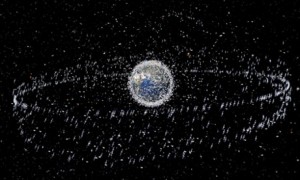Zap! Australian Scientists Look at Lasers to Cull Space Junk
SCIENCE, 10 Mar 2014
Pauline Askin, Reuters – TRANSCEND Media Service
It may sound like science fiction but an Australian team is working on a project to zap orbital debris with lasers from Earth to reduce the growing amount of space junk that threatens to knock out satellites with a “cascade of collisions”.

Space junk orbiting the Earth. Scientists estimate there are some 300,000 piece of debris circling the planet. Photograph: European Space Agency/Rex Feat
The project is very realistic and likely to be working in the next 10 years, Matthew Colless, director of Australian National University’s Research School of Astronomy and Astrophysics, told Reuters.
“It’s important that it’s possible on that scale because there’s so much space junk up there,” he said. “We’re perhaps only a couple of decades away from a catastrophic cascade of collisions … that takes out all the satellites in low orbit.”
Scientists believe there are more than 300,000 pieces of debris in space, made up of everything from tiny screws and bolts to large parts of rockets, mostly moving in low orbits around Earth at tremendous speed.
Australia now has a contract with NASA, the U.S. space agency, to track and map space junk with a telescope equipped with an infra-red laser at Mount Stromlo Observatory.
But $20 million from the Australian government and $40 million in private investment will help the team set up as the Cooperative Research Centre (CRC) to develop better lasers to track tiny pieces of debris, importing techniques from astronomy used to remove the blurring of the atmosphere.
The ultimate aim is to increase the power of the lasers to illuminate and zap pieces of junk so they burn up harmlessly as they fall through the upper atmosphere.
“There’s no risk of missing and hitting a working satellite,” Colless said. “We can target them precisely. We really don’t miss.”
Colless said he imagines an eventual need for a global network of stations set up under international auspices but, right now, the CRC is doing the research to make it possible.
The CRC is made up of universities, space agencies and companies including Lockheed Martin, Optus and EOS Space System Australia.
(Editing by John O’Callaghan)
DISCLAIMER: The statements, views and opinions expressed in pieces republished here are solely those of the authors and do not necessarily represent those of TMS. In accordance with title 17 U.S.C. section 107, this material is distributed without profit to those who have expressed a prior interest in receiving the included information for research and educational purposes. TMS has no affiliation whatsoever with the originator of this article nor is TMS endorsed or sponsored by the originator. “GO TO ORIGINAL” links are provided as a convenience to our readers and allow for verification of authenticity. However, as originating pages are often updated by their originating host sites, the versions posted may not match the versions our readers view when clicking the “GO TO ORIGINAL” links. This site contains copyrighted material the use of which has not always been specifically authorized by the copyright owner. We are making such material available in our efforts to advance understanding of environmental, political, human rights, economic, democracy, scientific, and social justice issues, etc. We believe this constitutes a ‘fair use’ of any such copyrighted material as provided for in section 107 of the US Copyright Law. In accordance with Title 17 U.S.C. Section 107, the material on this site is distributed without profit to those who have expressed a prior interest in receiving the included information for research and educational purposes. For more information go to: http://www.law.cornell.edu/uscode/17/107.shtml. If you wish to use copyrighted material from this site for purposes of your own that go beyond ‘fair use’, you must obtain permission from the copyright owner.